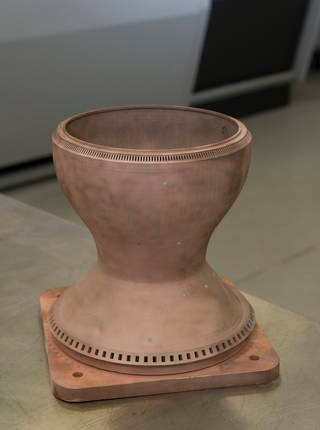The rocket engines currently in use for the exploration and exploitation of space are liquid fueled. Because they have to work in the vacuum of space, the fuel must be mixed with an oxidizer in order for combustion to occur. Elaborate systems have been developed to hold the different varieties of fuels and oxidizers in use. Complex systems of pipes and pumps deliver the fuel and oxidizer to the combustion chamber where they are mixed and burned. Creating combustion chambers which can withstand the heat of combustion that can reach over five thousand degrees Fahrenheit has been a long and difficult task.
Ten years ago, the U.S. Space Shuttle engines were the most sophisticated rocket engines developed up to that point. The shells of the main combustion chambers were made of an alloy called Iconel 718. Iconel alloys are a combination of iron, nickel and chromium with traces of other elements. They are heat resistant and often used in high temperature applications. Iconel 718 is about fifty percent nickel, twenty percent chromium, twenty percent iron and ten percent other elements. The lining of the combustion chamber is an alloy of copper, silver and zirconium alloy called NARloy-Z that was developed specifically for use in rocket engines. NARloy-Z is ninety six percent copper, three percent silver and one percent zirconium. It has excellent heat transfer properties and is resistant to corrosion and oxidation. The lining of the combustion chamber contains hundreds of tubes that carry coolant to lower the temperature.
During the use of the engines, the severe conditions inside the combustion chamber roughened the lining of the chamber in a process called "blanching". This meant that every time the Shuttle landed, the combustion chambers had to be polished to make the surface smooth again.
Special materials were developed to coat the lining of the chamber to prevent the blanching. Unfortunately, the difference in chemical composition between the coating and the liner resulted in different amounts of expansion under the heat of combustion. When this differential expansion reached a threshold, there was separation and flaking of the coating where it met the liner. So it was still necessary to perform maintenance on every landing.
Special materials were developed to coat the lining of the chamber to prevent the blanching. Unfortunately, the difference in chemical composition between the coating and the liner resulted in different amounts of expansion under the heat of combustion. When this differential expansion reached a threshold, there was separation and flaking of the coating where it met the liner. So it was still necessary to perform maintenance on every landing.
NASA worked to solve this problem by developing an advanced "vacuum plasma" process for depositing both the coating and the lining of the combustion chamber in a mold in layers. The new coating is a metallic alloy of nickel, chromium, aluminum and yttrium. By mixing the coating and lining and slowly varying the ratio of the two between one hundred percent lining and one hundred percent coating, they eliminate the sharp boundary between the two. The combination coating/lining is able to withstand more than a hundred firings without developing the previous problems that plagued rocket engine combustion chambers.
Recently NASA 3D printed a rocket engine combustion chamber liner complete with cooling channels. A powder of a special copper alloy called GRCop-84 was used to print the combustion chamber with a laser melting the powder as the part was printed. GRCop-84 is a high temperature copper alloy specifically developed by NASA for high-heat-flux application. It is composed of eighty eight percent copper, six and a half percent chromium and five and a half percent niobium and is superior to the NARloy-Z used in the Space Shuttle combustion chambers. After a shell of nickel alloy is deposited on the copper liner, the chamber will be tested. NASA hopes to be able to make rocket engine parts ten times faster than and at half the cost of the old manufacturing process.
3D printed copper alloy rocket engine combustion chamber:
